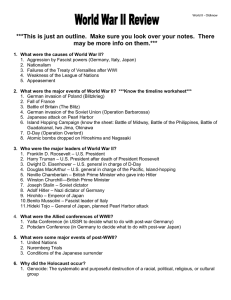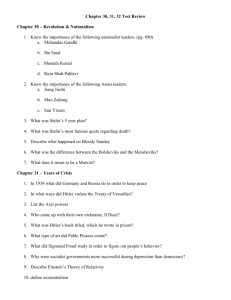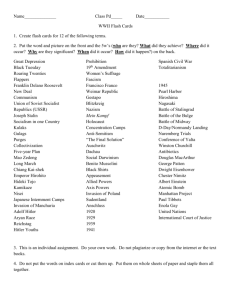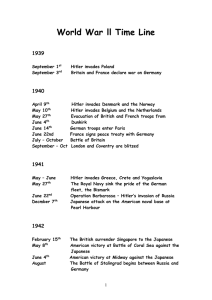NAME __________________________________ DATE____________________ (Germany, Italy, Spain)
advertisement
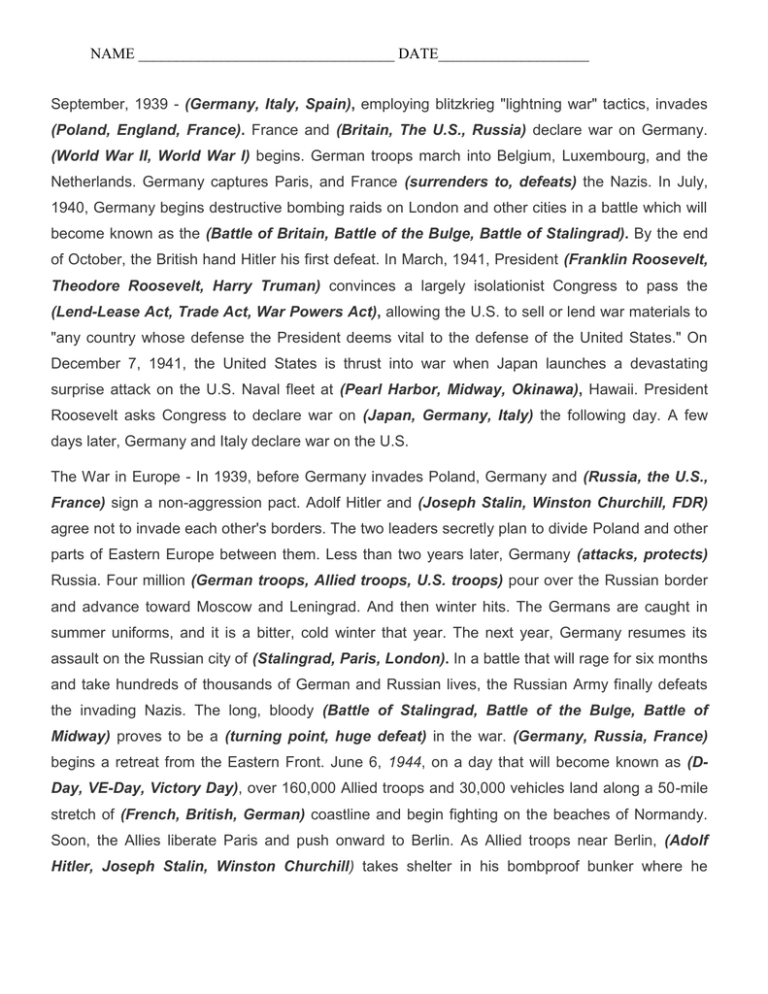
NAME __________________________________ DATE____________________ September, 1939 - (Germany, Italy, Spain), employing blitzkrieg "lightning war" tactics, invades (Poland, England, France). France and (Britain, The U.S., Russia) declare war on Germany. (World War II, World War I) begins. German troops march into Belgium, Luxembourg, and the Netherlands. Germany captures Paris, and France (surrenders to, defeats) the Nazis. In July, 1940, Germany begins destructive bombing raids on London and other cities in a battle which will become known as the (Battle of Britain, Battle of the Bulge, Battle of Stalingrad). By the end of October, the British hand Hitler his first defeat. In March, 1941, President (Franklin Roosevelt, Theodore Roosevelt, Harry Truman) convinces a largely isolationist Congress to pass the (Lend-Lease Act, Trade Act, War Powers Act), allowing the U.S. to sell or lend war materials to "any country whose defense the President deems vital to the defense of the United States." On December 7, 1941, the United States is thrust into war when Japan launches a devastating surprise attack on the U.S. Naval fleet at (Pearl Harbor, Midway, Okinawa), Hawaii. President Roosevelt asks Congress to declare war on (Japan, Germany, Italy) the following day. A few days later, Germany and Italy declare war on the U.S. The War in Europe - In 1939, before Germany invades Poland, Germany and (Russia, the U.S., France) sign a non-aggression pact. Adolf Hitler and (Joseph Stalin, Winston Churchill, FDR) agree not to invade each other's borders. The two leaders secretly plan to divide Poland and other parts of Eastern Europe between them. Less than two years later, Germany (attacks, protects) Russia. Four million (German troops, Allied troops, U.S. troops) pour over the Russian border and advance toward Moscow and Leningrad. And then winter hits. The Germans are caught in summer uniforms, and it is a bitter, cold winter that year. The next year, Germany resumes its assault on the Russian city of (Stalingrad, Paris, London). In a battle that will rage for six months and take hundreds of thousands of German and Russian lives, the Russian Army finally defeats the invading Nazis. The long, bloody (Battle of Stalingrad, Battle of the Bulge, Battle of Midway) proves to be a (turning point, huge defeat) in the war. (Germany, Russia, France) begins a retreat from the Eastern Front. June 6, 1944, on a day that will become known as (DDay, VE-Day, Victory Day), over 160,000 Allied troops and 30,000 vehicles land along a 50-mile stretch of (French, British, German) coastline and begin fighting on the beaches of Normandy. Soon, the Allies liberate Paris and push onward to Berlin. As Allied troops near Berlin, (Adolf Hitler, Joseph Stalin, Winston Churchill) takes shelter in his bombproof bunker where he NAME __________________________________ DATE____________________ poisons his mistress and shoots himself. The war in Europe is over, but the war in the Pacific is still being fought. War in the Pacific - Following the attack on Peal Harbor on December 7, (1941, 1939, 1943), (Japanese, German, U.S.) armies roll over Southeast Asia, the Philippines, and the East Indies. The war in the Pacific is fought on land, at sea, and in the air. The (turning point, end, beginning) in the war in the Pacific comes in June, 1942 at the Battle of (Midway, Stalingrad, Pearl Harbor). In this four day battle fought between aircraft based on giant aircraft carriers, the U.S. destroys hundreds of Japanese planes and regains control of (the Pacific, Europe). The Japanese continue to fight on, however, even after Hitler's defeat ends the war in Europe. President (Truman, Roosevelt, Eisenhower) decides to use the newly developed (atomic bomb, airplane, aircraft carrier) to end the war in the Pacific quickly and prevent more U.S. casualties. The Enola Gay first drops an atomic bomb on (Hiroshima, Japan, Nagasaki, Japan) on August 6, 1945, killing about 78,000 people and injuring 100,000 more. On August 9, a second bomb is dropped on (Nagasaki, Japan, Hiroshima, Japan), killing another 40,000 people. (Japan, Germany, the U.S.) is forced to surrender and World War II finally comes to an end.
